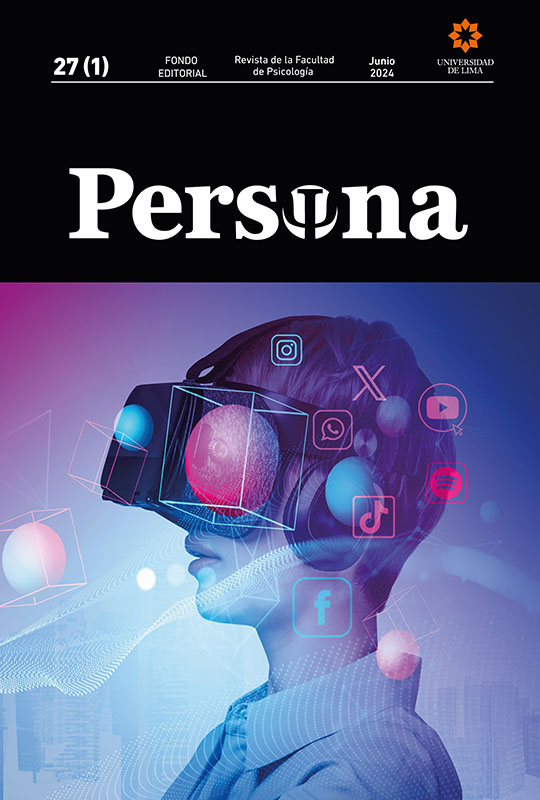Objetos simbólicos y su doble realidad. Un recorrido hacia la comprensión simbólica de imágenes de realidad virtual en la infancia
DOI:
https://doi.org/10.26439/persona2024.n27(1).6632Palabras clave:
realidad virtual, comprensión simbólica, imágenes, tecnología inmersiva, educaciónResumen
Partiendo de autores clásicos y de trabajos empíricos, este artículo propone una discusión sobre los interrogantes que, por sus características específicas, plantea la realidad virtual en la comprensión de sus imágenes como objetos simbólicos en la infancia temprana. Los objetos simbólicos son entidades que desde tiempos inmemoriales han sido creadas con la intención de representar algo diferente a ellas mismas, por lo que se considera que tienen una naturaleza doble. Existen numerosos estudios respecto a la comprensión de diversos objetos simbólicos, como maquetas, dibujos y mapas; también, y más recientemente, de imágenes plasmadas en tecnologías digitales táctiles como tablets o smartphones. Sin embargo, los interrogantes que plantean las imágenes inmersivas, como representaciones de la realidad, aún no han sido abordados. Este trabajo fundamentalmente discute la pregunta sobre la comprensión simbólica de las imágenes de realidad virtual en la niñez temprana y, también, su posible utilización en el campo educativo.
Descargas
Referencias
Avendaño Ruz, C. (2018). La memoria reconstruida. Revista Enfoques Educacionales, 1(2), 143-145. https://doi.org/10.5354/0717-3229.1998.48634
Bailey, J. O., & Bailenson, J. N. (2017). Immersive virtual reality and the developing child. En F. C. Blumberg & P. J. Brooks (Eds.), Cognitive development in digital contexts (pp. 181-200). Elsevier Academic Press. https://doi.org/10.1016/B978-0-12-809481-5.00009-2
Bloom, P., & Markson, L. (1998). Capacities underlying word learning. Trends in Cognitive Sciences, 2(2), 67-73. https://doi.org/10.1016/S1364-6613(98)01121-8
Brizuela, B. M., & Scheuer, N. (2016). Investigating cognitive change as a dynamic process / Investigar el cambio cognitivo como proceso dinámico. Infancia y Aprendizaje, 39(4), 627-660. https://doi.org/10.1080/02103702.2016.1223710
Bruner, J. (1980). The social context of language acquisition (Witkin Memorial Lecture). Educational Testing Services.
Bruner, J. (1984). Acción, pensamiento y lenguaje. Alianza Editorial.
Bruner, J. (1990). Acts of meaning. Harvard University Press.
Bruner, J. (1991). Actos de significado: más allá de la revolución cognitiva. Alianza Editorial.
Bruner, J. S., & Olson, D. R. (1973). Aprendizaje por experiencia directa y aprendizaje por experiencia mediatizada. Perspectivas, 3(1), 21-41.
Bruner, J., & Sherwood, V. (1975). Peekaboo and the learning of rule structures. En J. Bruner & K. Sylva (Eds.), Play: Its role in development and evolution (pp. 277-285). Penguin Books.
Buttussi, F., & Chittaro, L. (2018). Effects of different types of virtual reality display on presence and learning in a safety training scenario. IEEE Transactions on Visualization and Computer Graphics, 24(2), 1063-1076. https://doi.org/10.5824/ajite.2020.03.008.x
Callaghan, T., Moll, H., Rakoczy, H., Warneken, F., Liszkowski, U., Behne, T., & Tomasello, M. (2011). Early social cognition in three cultural contexts. Monographs of the Society for Research in Child Development, 76(2), 1-142. https://doi.org/10.1111/j.1540-5834.2011.00603.x
Calil, J., Fauville, G., Queiroz, A., Leo, K., Mann, A., Wise-West, T., Salvatore, P., & Bailenson, J. (2021). Using virtual reality in sea level rise planning and community engagement – An overview. Water, 13(9), 1142. https://doi.org/10.3390/w13091142
Cañellas-Mayor, A. (2017). Apuntes docentes: posibilidades educativas de la realidad virtual inmersiva. Centro de Comunicación y Pedagogía, 13(9), 1142.
Cummings, J. J., & Bailenson, J. N. (2016). How immersive is enough? A meta-analysis of the effect of immersive technology on user presence. Media Psychology, 19(2), 272-309. https://doi.org/10.1080/15213269.2015.1015740
DeLoache, J. S. (1987). Rapid change in the symbolic functioning of very young children. Science, 238(4833), 1556-1557. https://doi.org/10.1126/science.2446392
DeLoache, J. S. (1991). Symbolic functioning in very young children: Understanding of pictures and models. Child Development, 62(4), 736-752. https://doi.org/10.2307/1131174
DeLoache, J. S. (1995). Early understanding and use of symbols: The model model. Current Directions in Psychological Science, 4(4), 109-113. https://doi.org/10.1111/1467-8721.ep10772408
DeLoache, J. S., & Burns, N. M. (1994). Early understanding of the representational function of pictures. Cognition, 52(2), 83-110. https://doi.org/10.1016/0010-0277(94)90063-9
DeLoache, J. S., Miller, K. F., & Rosengren, K. S. (1997). The credible shrinking room: Very young children’s performance with symbolic and nonsymbolic relations. Psychological Science, 8(4), 308-313. https://doi.org/10.1111/j.1467-9280.1997.tb00443.x
DeLoache, J., Peralta, O., & Anderson, K. (1999). Multiple factors in early symbol use. Cognitive Development, 14(2), 299-312. https://doi.org/10.1016/s0885-2014(99)00006-4
DeLoache, J. S., Pierroutsakos, S. L., & Troseth, G. L. (1996). The three Rs of pictorial competence. En R. Vasta (Ed.), Annals of child Development. Vol. 12 (pp. 1-48). Kingsley.
Díaz, P., & Peralta, O. (2024). Realidad virtual y pantallas digitales: un estudio comparativo sobre la comprensión simbólica infantil en entornos digitales e inmersivos [Manuscrito en preparación].
Di Paolo, E. (2013). El enactivismo y la naturalización de la mente. En D. P. Chico & M. G. Bedia (Eds.), Nueva ciencia cognitiva: hacia una teoría integral de la mente (pp. 1-39). Plaza y Valdés.
Dirección Provincial de Educación Inicial. (2022). Diseño curricular para la educación inicial. Primer ciclo. Gobierno de la Provincia de Buenos Aires.
Fransson, G., Holmberg, J., & Westelius, C. (2020). The challenges of using head-mounted virtual reality in K-12 schools from a teacher perspective. Educational Information Technology, 25, 3383-3404. https://doi.org/10.1007/s10639-020-10119-1
Gubern, R. (1996). Del bisonte a la realidad virtual. Anagrama.
Haggard, P., & Chambon, V. (2012). Sense of agency. Current Biology, 22(10), R390-2. https://doi.org/10.1016/j.cub.2012.02.040
Jauck, D., & Peralta, O. (2019). Two-year-olds’ symbolic use of images provided by a tablet: A transfer study. Frontiers in Psychology, 10, Article 2891. https://doi.org/10.3389/fpsyg.2019.02891
Kilteni, K., Groten, R., & Slater, M. (2012). The sense of embodiment in virtual reality. Presence: Teleoperators and Virtual Environments, 21(4), 373-387. https://doi.org/10.1162/pres_a_00124
Lanier, J. (1988). A vintage virtual reality interview. Whole Earth Review Magazine. http://www.well.com/user/jaron/vrint.html
Lawrence, J., & Valsiner, J. (1993). Conceptual roots of internalization: From transmission to transformation. Human Development, 36, 150-167.
Makransky, G., & Lilleholt, L. (2018). A structural equation modeling investigation of the emotional value of immersive virtual reality in education. Educational Technology Research and Development, 66(5), 1141-1164. https://doi.org/10.1007/s11423-018-9581-2
Makransky, G., & Petersen, G. B. (2021). The Cognitive Affective Model of Immersive Learning (CAMIL): A theoretical research-based model of learning in immersive virtual reality. Educational Psychology Review, 33(3), 937-958. https://doi.org/10.1007/s10648-020-09586-2
Markowitz, D. M., & Bailenson, J. N. (2021). Virtual reality and the psychology of climate change. Current Opinion in Psychology, 42, 60-65. https://doi.org/10.1016/j.copsyc.2021.03.009
Markowitz, D. M., Laha, R., Perone, B. P., Pea, R. D., & Bailenson, J. N. (2018). Immersive virtual reality field trips facilitate learning about climate change. Frontiers in Psychology, 9, 2364. https://doi.org/10.3389/fpsyg.2018.02364
Martí, E. (2003). Representar el mundo externamente. La adquisición infantil de los sistemas externos de representación. Visor.
McNeil, N. M., & Uttal, D. H. (2009). Rethinking the use of concrete materials in learning: Perspectives from development and education. Child Development Perspectives, 3(3), 137-139. https://doi.org/10.1111/j.1750-8606.2009.00093.x
Moreira Ortiz, W. W., & Castro Bermúdez, I. E. (2022). Las imágenes como recurso visual para potenciar la comprensión lectora en los niños de 4-5 años. Educare, 26(1), 193-214. https://doi.org/10.46498/reduipb.v26iExtraordinario.1705
Mulders, M., Buchner, J., & Kerres, M. (2020). A framework for the use of immersive virtual reality in learning environments. International Journal of Emerging Technologies in Learning (iJET), 15(24), 208-224. https://doi.org/10.3991/ijet.v15i24.16615
Mystakidis, S. (2022). Metaverse. Encyclopedia, 2(1), 486-497. https://doi.org/10.3390/encyclopedia2010031
Mystakidis, S., & Lympouridis, V. (2023). Immersive learning. Encyclopedia, 3(2), 396-405. https://doi.org/10.3390/encyclopedia3020026
Palma Stade, T., Schofield, G., & Moore, G. (2023). Narrative perspectives and embodiment in cinematic virtual reality. En L. T. De Paolis, P. Arpaia & M. Sacco (Eds.), Extended reality. International conference, XR Salento 2023 (pp. 396-405). Springer. https://doi.org/10.1007/978-3-031-43401-3_16
Passig, D., Tzuriel, D., & Eshel-Kedmi, G. (2016). Improving children’s cognitive modifiability by dynamic assessment in 3D immersive virtual reality environments. Computers & Education, 95, 296-308. https://doi.org/10.1016/j.compedu.2016.01.009
Pedrosa, D., Morgado, L., & Beck, D. (2023). Immersive learning environments for self-regulation of learning: A literature review. En D. Beck, A. Peña-Rios, T. Ogle, D. Economou, M. Mentzelopoulos, L. Morgado, C. Eckhardt, J. Pirker, R. Koitz-Hristov, J. Richter, C. Gütl & M. Gardner (Eds.), Immersive learning research network (pp. 497-511). Springer. https://doi.org/10.1007/978-3-031-47328-9_36
Peralta, O., Salsa, A., Maita, M., & Mareovich, F. (2013). Scaffolding young children´s understanding of symbolic objects. Early Years: An International Journal of Research and Development, 33(3), 266-274.
Petersen, G., Petkakis, G., & Makransky, G. A (2022). A study of how immersion and interactivity drive VR learning. Computers & Education, 179(C), 104429. https://doi.org/10.1016/j.compedu.2021.104429.
Piaget, J. (1962). The stages of the intellectual development of the child. Bulletin of the Menninger Clinic, 26(3), 120-128.
Piaget, J. (1973). Seis estudios de psicología. Seix Barral.
Pirker, J., Kopf, J., Kainz, A., Dengel, A., & Buchbauer, B. (2021). The potential of virtual reality for computer science education. Engaging students through immersive visualizations [Ponencia]. 2021 IEEE Conference on Virtual Reality and 3D User Interfaces Abstracts and Workshops (VRW), realizado del 27 de marzo al 3 de abril como evento virtual.
Queiroz, A. C. M., Fauville, G., Abeles, A. T., Levett, A., & Bailenson, J. N. (2023). The efficacy of virtual reality in climate change education increases with amount of body movement and message specificity. Sustainability, 15, 5814. https://doi.org/10.3390/su15075814
Rodríguez-Vázquez, A., García-Ruiz, R., & Aguaded, I. (2020). Políticas públicas en educación y comunicación: debates y avances. Tripodos, Blanquerna School of Communication and International Relations, 46, 43-57. https://raco.cat/index.php/Tripodos/article/view/369933
Ryan, M.-L. (1999). Immersion vs. interactivity: Virtual reality and literary theory. SubStance, 28(2), 110-137. https://doi.org/10.2307/3685793
Ryan, M.-L. (2004). La narración como realidad virtual. Paidós.
Salsa, A., & Peralta, O. (2007). Routes to symbolization: Intentionality and correspondence in early understanding of pictures. Journal of Cognition and Development, 8(1), 79-92. https://doi.org/10.1207/s15327647jcd0801_4
Sartori, M., & Peralta, O. (2022). Children’s symbolic understanding of a digital, three-dimensional, interactive image. Infancia y Aprendizaje, 45(2), 351-381. https://doi.org/10.1080/02103702.2021.1989648
Sheehan, K. J., & Uttal, D. H. (2016). Children’s learning from touch screens: A dual representation perspective. Frontiers in Psychology, 7, Article 1220. https://doi.org/10.3389/fpsyg.2016.01220
Sherman, W. R., & Craig, A. B. (2003). Understanding virtual reality –interface, application, and design. Presence, 12(4), 441-442. https://doi.org/10.1162/105474603322391668
Shin, D., & Biocca, F. (2018). Exploring immersive experience in journalism. New Media & Society, 20(8), 2800-2823. https://doi.org/10.1177/1461444817733133
Smirnov, D. A., Tereshchenko, E. A., Botasheva, L. E., Trofimov, M. S., Melnikova, V. A., & Dolgopolov, K. A. (2020). Digital jurisprudence. Inclusiones, 7(1), 273-283.
Subsecretarías de Desarrollo Curricular y Formación Docente y de Educación Inicial, Comisión de Escrituración. (2023). Diseño curricular para la educación inicial – Santa Fe. Ministerio de Educación de la Provincia de Santa Fe.
Tare, M., Chiong, C., Ganea, P., & DeLoache, J. (2010). Less is more: How manipulative features affect children’s learning from picture books. Journal of Applied Developmental Psychology, 1(5), 395-400. https://doi.org/10.1016/j.appdev.2010.06.005
Tomasello, M. (1999). The cultural ecology of young children’s interactions with objects and artifacts. En W. Hirst (Ed.), Ecological approaches to cognition: Essays in honor of Ulric Neisser (pp. 153-170). Lawrence Erlbaum Associates.
Tomasello, M. (2008). Origins of human communication. The MIT Press.
Troseth, G. L., & DeLoache, J. S. (1998). The medium can obscure the message: Young children’s understanding of video. Child Development, 69(4), 950-965. https://doi.org/10.1111/j.1467-8624.1998.tb06153.x
Troseth, G. L., & Strouse, G. A. (2024). In modeling digital learning, remember pictorial competence. Journal of Applied Research in Memory and Cognition, 12(4), 491-496. https://doi.org/10.1037/mac0000150
Troseth, G. L., Pierroutsakos, S. L., & DeLoache, J. S. (2004). From the innocent to the intelligent eye: The early development of pictorial competence. Advances in Child Development and Behavior, 32, 1-35. https://doi.org/10.1016/s0065-2407(04)80003-x
Uttal, D. H., O’Doherty, K., Newland, R., Hand, L. L., & DeLoache, J. (2009). Dual representation and the linking of concrete and symbolic representations: Dual representation. Child Development Perspectives, 3(3), 156-159. https://doi.org/10.1111/j.1750-8606.2009.00097.x
Yeo, N., White, M., Alcock, I., Garside, R., Dean, S. G., Smalley, A. J., & Gatersleben, B. (2020). What is the best way of delivering virtual nature for improving mood? An experimental comparison of high definition TV, 360o video, and computer generated virtual reality. Journal of Environmental Psychology, 72, Article 101500. https://doi.org/10.1016/j.jenvp.2020.101500
Varela, F. (1996). Conocer. Las ciencias cognitivas: tendencias y perspectivas. Cartografía de las ideas actuales. Gedisa.
Vygotsky, L. S. (1978). Mind in society: The development of higher psychological processes. Harvard University Press.
Wood, D., Bruner, J., & Ross, G. (1976). The role of tutoring in problem solving. Journal of Child Psychology and Psychiatry, 17, 89-100.
Zhou, Y., Chen, J., & Wang, M. (2022). A meta-analytic review on incorporating virtual and augmented reality in museum learning. Educational Research Review, 36, 100454, https://doi.org/10.1016/j.edurev.2022.100454
Publicado
Número
Sección
Licencia
La aceptación de publicación implica ceder los derechos de impresión y de reproducción por cualquier forma y medio al editor, manteniendo el autor la propiedad intelectual del artículo.











